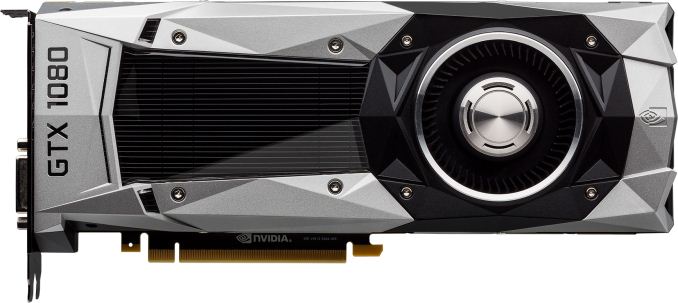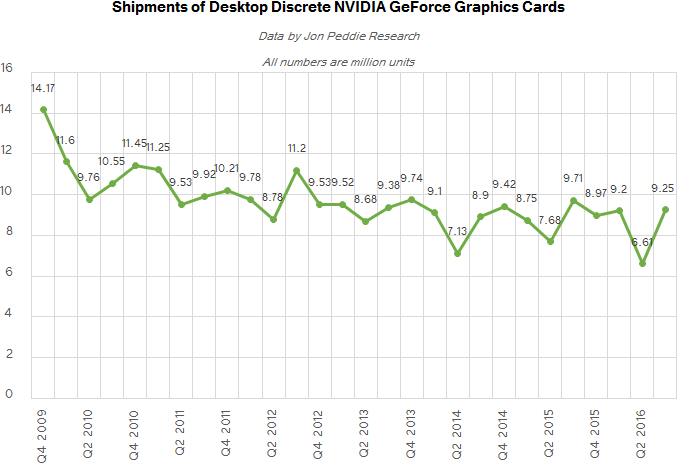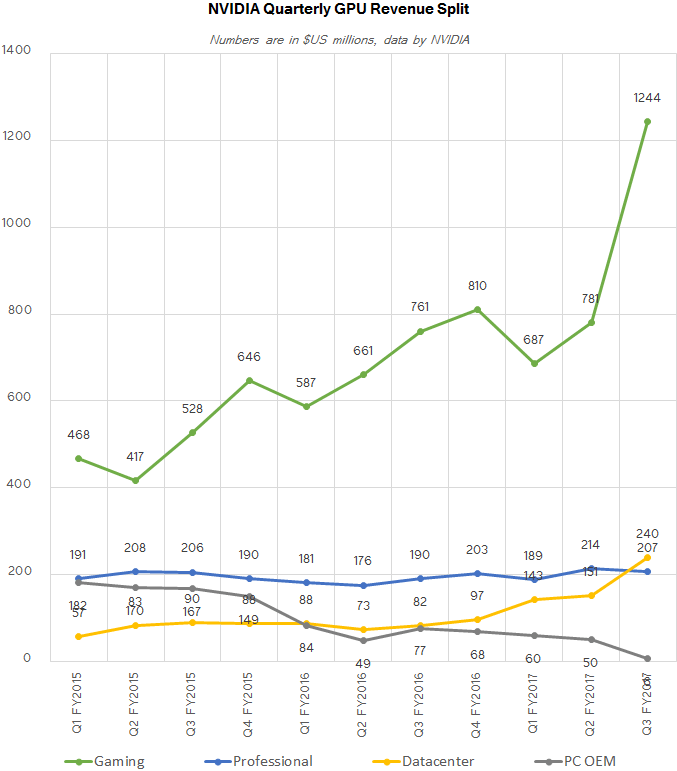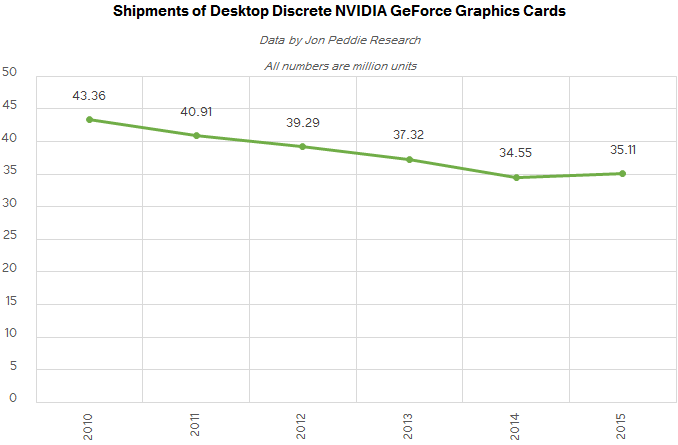Discrete Desktop GPU Market Trends Q3 2016: GPU Shipments Hit Two-Year High
by Anton Shilov on November 28, 2016 9:00 AM ESTNVIDIA: Record Sales of Gaming GPUs
Jon Peddie Research reports that NVIDIA shipped approximately 9.25 million desktop GPUs (up 39.8% QoQ) and increased its notebook GPU shipments by 38.7% sequentially in calendar Q3. NVIDIA does not officially disclose the number of graphics processors it sells, but the company’s revenue for gaming-grade GPUs skyrocketed to $1.244 billion in its Q3 FY2017 (ended October 30, 2016), so it is logical to assume that shipments of its graphics chips (both for desktops and notebooks) were very strong in the calendar third quarter as well.
“Gaming revenue crossed the $1 billion mark and increased 63% year-on-year to a record $1.24 billion, fueled by our Pascal-based GPUs,” said Colette M. Kress, CFO of NVIDIA, during the company’s earnings conference call. “Demand was strong in every geographic region across desktop and notebook, and across the full gaming audience, from GTX 1050 to the TITAN X.”
NVIDIA itself attributes its success in the third quarter to sales of its Pascal-based products — the GeForce GTX 1060, 1070 and 1080 as well as their mobile brethren. Since such boards start at $199 and their ASP should be considerably higher than that, it is not surprising that NVIDIA earned a lot despite a decrease in unit sales compared to Q3 in 2015. Unfortunately, we do not know exact rankings of AMD and NVIDIA in the enthusiast part of the market in terms of units, but it looks like the green company commands the lion’s share of this lucrative segment in terms of both units and dollars. Moreover, this situation is going to last for some time before AMD introduces its next-generation Greenland/Vega GPUs.
For the three-quarters so far in 2016, NVIDIA has sold approximately 25 million of desktop discrete GPUs. This is ~4% lower than in the first three quarters of 2015 (around 26 million). Nonetheless, despite slightly lower unit sales, the company is thriving financially due to higher ASPs. Moreover, NVIDIA’s management implies that demand for its desktop GPUs is still very high and sales of graphics cards may increase in Q4 as a result of improved yields and/or increased allocation at TSMC. If this happens, the company could sell around 35 million desktop GPUs in total this year, the same amount as in 2015.
“In terms of Pascal, we are still ramping,” said Jen-Hsun Huang, CEO of NVIDIA. “Production is fully ramped in the sense that all of our products are [certified and qualified with OEMs], they are on the market. However, demand is still high. So, we are going to continue to work hard, and our manufacturing partner TSMC is doing a great job for us.”














53 Comments
View All Comments
Shadowmaster625 - Monday, November 28, 2016 - link
It's actually rather sad that discrete GPU sales are only up 10% vs a year ago when they had been sandbagging on 2011 process tech for 4 years. I would have expected 14nm/16nm to provide a larger boost to sales.lefty2 - Monday, November 28, 2016 - link
This is because no one is buying desktops anymore. All the top tech companies give there employees laptops, not desktops: http://www.techworm.net/2016/11/computerlaptop-big...TheinsanegamerN - Monday, November 28, 2016 - link
And the majority of those desktops were using integrated solutions, not dedicated ones. Business moving to laptops hasnt had that big of an impact.Sarah Terra - Tuesday, December 13, 2016 - link
The slower sales are because of this reason: Nvidia has been milking process and architures for abnormal periods in order to maximize profts. As such a 2-3 generation old GPU is usually still "good enough" for most poeple, much like how users clung to sandy bridge. Back in the day, if you had a 3 year old GPU you were left in the dust, upgrades were far more frequent and necessary to keep pace. Nvidia is eseentially monopolizing themselves to a smaller market share, more competition will boost sales.Atique786 - Friday, October 1, 2021 - link
This is a very informative and interesting article. I have enjoyed reading your post and have come to the conclusion that you are a professional writer.https://realrelaxmassagechairreview.com/
<a href="https://realrelaxmassagechairreview.com/">... Relax Massage Chairs</a>
<a href="https://realrelaxmassagechairreview.com/real-relax... Relax Massage Chair Review</a>
<a href="https://realrelaxmassagechairreview.com/real-relax... Relax 2020 Massage Chair</a>
OldManMcNasty - Thursday, December 8, 2016 - link
Our engineers get whatever they want, I have a SurFace Pro 4 but I also have a virtual workstation with a Nvidia vGPU. If you're not an engineer, you're given a virtual desktop or you can select an iPad.Amna - Monday, February 14, 2022 - link
I really like the blog.I have shared your site with many friends and family. It is always a pleasure to read.<a href="https://realrelaxmassagechairreview.com/real-relax... Real Relax Massage Chair</a>
nathanddrews - Monday, November 28, 2016 - link
Larger than 10%? Why would you expect that?DanNeely - Wednesday, November 30, 2016 - link
Steadily bigger died and more efficient 28nm designs kept the performance gains coming, despite the process lag there wasn't a correspondingly huge buildup of demand.BurntMyBacon - Thursday, December 1, 2016 - link
@Shadowmaster625: "It's actually rather sad that discrete GPU sales are only up 10% vs a year ago when they had been sandbagging on 2011 process tech for 4 years."You are making a perhaps faulty assumption that most people buying GPUs know or care what processes nodes do for the video card they are buying. In my estimation, more people are concerned with how much it costs and if it does what they want it to do. I don't suspect many of them track how new cards compare to the last gen products, much less the several generations back that they would need to know to be aware of the process node stall.